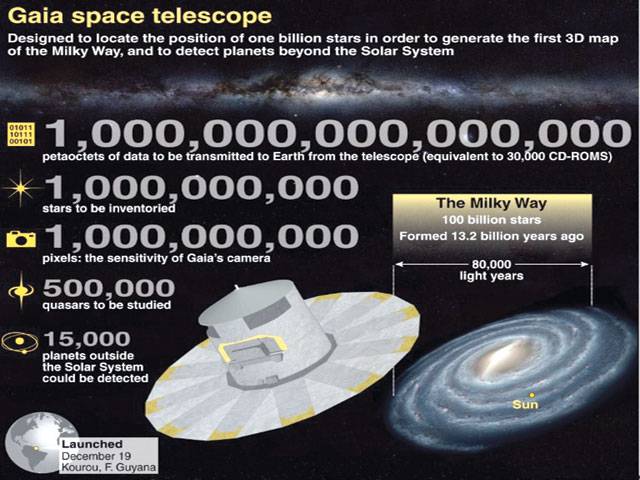BBC
PARIS -Europe has launched the Gaia satellite - one of the most ambitious space missions in history. The 740m-euro (£620m) observatory lifted off from the Sinnamary complex in French Guiana at 06:12 local time (09:12 GMT). Gaia is going to map the precise positions and distances to more than a billion stars.
This should give us the first realistic picture of how our Milky Way galaxy is constructed. Gaia’s remarkable sensitivity will lead also to the detection of many thousands of previously unseen objects, including new planets and asteroids. Separation from the Soyuz upper-stage was confirmed just before 10:00 GMT. The satellite is now travelling out to an observing station some 1.5 million km from the Earth on its nightside - a journey that will take about a month to complete. Gaia has been in development for more than 20 years.
It will be engaged in what is termed astrometry - the science of mapping the locations and movements of celestial objects. To do this, it carries two telescopes that throw light on to a huge, one-billion-pixel camera detector connected to a trio of instruments. Gaia will use this ultra-stable and supersensitive optical equipment to pinpoint its sample of stars with extraordinary confidence. By repeatedly viewing its targets over five years, it should get to know the brightest stars’ coordinates down to an error of just seven micro-arcseconds.
“This angle is equivalent to the size of a euro coin on the Moon as seen from Earth,” explained Prof Alvaro Gimenez, Esa’s director of science. Gaia will compile profiles on the stars it sees. As well as working out how far away they are, the satellite will study their motion across the sky. Their physical properties will also be catalogued - details such as brightness, temperature, and composition. It should even be possible then to determine their ages. And for about 150 million of these stars, Gaia will measure their velocity either towards or away from us.
Friday, April 26, 2024
EU launches billion-dollar Milky Way telescope

3:15 PM | April 24, 2024
Vloggers Shiraz, Muskan cross 2m followers on Instagram
12:27 AM | April 26, 2024
Achakzai stresses collective wisdom to address country's crises
12:27 AM | April 26, 2024
IHC puts off cipher case hearing until April 30
12:26 AM | April 26, 2024
Nawaz Sharif convenes PML-N Punjab meeting tomorrow
12:25 AM | April 26, 2024
ECP reinstates PTI-backed MNA from NA-81 Gujranwala
12:24 AM | April 26, 2024
Academic Uprising
April 24, 2024
Cooperation Momentum
April 24, 2024
Facing Reality
April 24, 2024
Absent Academia
April 23, 2024
Murree’s Redemption
April 23, 2024
Ending animal suffering
April 25, 2024
AI governance
April 25, 2024
AI concerns
April 25, 2024
Population paradox
April 24, 2024
Unveiling differences
April 24, 2024
ePaper - Nawaiwaqt
Advertisement
Nawaiwaqt Group | Copyright © 2024





